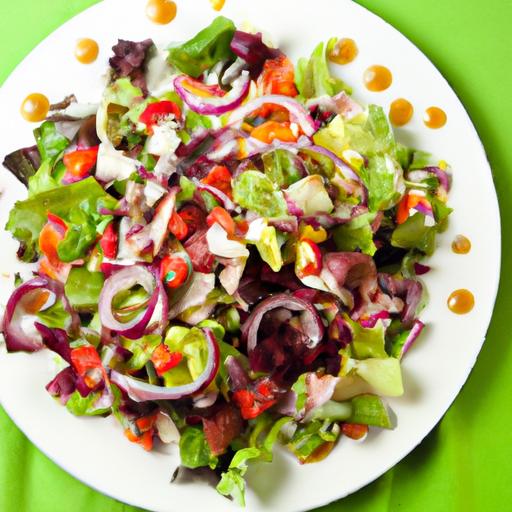Few things are as satisfying as a crisp, vibrant salad bursting with fresh flavors – until the moment your carefully crafted greens turn soggy or your dressing separates in an unappetizing way. Keeping salads fresh and dressings perfectly balanced can feel like a culinary challenge, but with a few smart storage tricks, you can extend the life of your leafy masterpieces and preserve that delicious burst of flavor every time. In this article, we’ll explore clever, easy-to-follow tips for storing salad dressings and ingredients, ensuring your salads stay as fresh and inviting as the day you made them. Say goodbye to wilted leaves and watery dressings, and hello to salad perfection!
Choosing the right containers to preserve salad dressings is crucial for maintaining their freshness, texture, and vibrant flavors. Whether you’re storing a zesty vinaigrette or a creamy tahini-based dressing, opting for airtight glass jars or BPA-free bottles helps prevent oxidation and contamination, keeping your homemade dressings delicious for longer. Glass containers with tight-sealing lids are especially ideal because they do not absorb odors or stains, allowing your dressings to retain true flavor.
Optimal Temperature Settings for Extending Freshness
Keeping dressings at an optimal temperature slows bacterial growth and preserves freshness. Most dressings perform best when stored in the refrigerator at about 35°F to 40°F (1.7°C to 4.4°C). Avoid door storage where temperature fluctuations are common; instead, place containers on a middle shelf to ensure consistent coolness. For oil-based vinaigrettes, refrigeration solidifies some oils-simply let the dressing sit at room temperature for a few minutes before shaking well to restore smoothness.
Separation Techniques to Maintain Texture and Flavor
Many homemade dressings naturally separate due to their oil and vinegar or dairy components. To maintain a creamy and balanced texture, vigorous shaking or stirring before each use is essential. Using a container with ample headspace makes shaking more effective without spillage. To further prevent unwanted separation, consider emulsifying ingredients by gradually whisking the oil into the acidic base while adding a small pinch of mustard or a bit of honey-both act as natural emulsifiers and enhance the flavor profile.
Creative Storage Solutions for Homemade Dressings
Beyond classic jars, repurposed mini glass bottles or vintage soap dispensers offer charming and practical storage options that elevate your refrigerator aesthetics. Label each container with the dressing name and date using waterproof stickers or chalkboard tags for easy reference. For frequent use, prepare single-serving portions in small glass cups or mason jar shot glasses. This way, you avoid repeated exposure of the larger batch to air, preserving freshness longer.

Prep and Cook Time
- Preparation: 10 minutes
- Storage Setup: 5 minutes
- Total Time: 15 minutes
Yield
Approximately 2 cups of homemade dressing per container
Difficulty Level
Easy
Ingredients
- 2 cups mixed salad dressing bases (vinaigrette, creamy base, or yogurt dressing)
- 1 airtight glass jar or BPA-free bottle, capacity 2 cups or more
- 1 tsp Dijon mustard (optional, as a natural emulsifier)
- 1 tsp honey or maple syrup (optional, for taste and texture)
- Labels or tags to mark dressing type and date
Instructions
- Prepare your dressing: Whisk together your dressing ingredients in a bowl, adding mustard or honey slowly to emulsify and enhance texture.
- Select the container: Choose a clean, dry glass jar or BPA-free bottle with a tight seal to prevent air exposure.
- Transfer the dressing: Pour the dressing into your chosen container, leaving about 1 inch of headspace to allow for shaking before use.
- Seal and label: Secure the lid tightly and write the dressing name and date on the label or tag for easy identification.
- Refrigerate strategically: Store the container on a middle shelf away from the refrigerator door for consistent temperature maintenance.
- Shake before serving: Always shake the container vigorously before each use to recombine separated ingredients, ensuring smoothness and flavor balance.
Tips for Success
- Glass containers are best for preserving flavors as they don’t leach odors.
- Avoid metal lids that may rust; if using, ensure they have a plastic lining.
- If separation happens frequently, add an extra teaspoon of mustard or use an immersion blender to achieve better emulsification.
- When using creamy dressings with dairy or eggs, consume within 5-7 days for optimal freshness and safety.
- Consider freezing dressings like vinaigrettes in ice cube trays for long-term storage; thaw as needed.
Serving Suggestions
Present your salad dressings alongside fresh greens, roasted vegetables, or grilled proteins in small, charming glass containers for an inviting display. Garnish salads with microgreens or freshly cracked pepper to complement the dressing’s flavor. Offering a trio of dressings in labeled glass jars adds elegance to any meal and invites guests to customize their plates.
| Nutrient | Amount per 2 tbsp |
|---|---|
| Calories | 80-150 kcal |
| Protein | 0.2 g |
| Carbohydrates | 2-4 g |
| Fat | 7-14 g |
For more tips on maintaining salad freshness and creative serving ideas, check out our Fresh Ingredients Preservation Guide. To deepen your understanding of emulsification science, visit this Science Daily article on food emulsions.
Q&A
Q&A: Keep Salads Fresh – Smart Storage Tips for Dressings
Q1: Why is storing salad dressings separately important for salad freshness?
A1: Salad dressings contain acids, oils, and other ingredients that can quickly wilt or soggy your greens. Keeping them separate until serving preserves the crisp texture and vibrant appearance of your salad, making every bite fresh and delightful.
Q2: What are the best containers to store dressings in?
A2: Airtight, leak-proof glass jars or bottles with easy-pour spouts are ideal. Glass doesn’t absorb odors or stains, helping your dressing maintain its original flavor and color. Plus, see-through containers let you track how much dressing is left!
Q3: How long can homemade salad dressings be stored safely?
A3: Most homemade dressings last about one to two weeks in the refrigerator. Dressings with fresh herbs or dairy should be consumed within 5-7 days to avoid spoilage. Always label your dressing with the date for peace of mind.
Q4: Can I prepare dressings in bulk and freeze them?
A4: Yes, some dressings freeze well, especially vinaigrettes without dairy. Freeze them in ice cube trays for convenient portions, then thaw cubes as needed. However, creamy dressings may change texture and separate after freezing.
Q5: How can I keep dressings from separating during storage?
A5: Give your dressing a good shake or stir before each use. To maintain consistency, add a natural emulsifier like mustard or a small amount of honey when making your dressing. These help blend oil and vinegar into a smooth mixture.
Q6: Are there any storage tips to enhance salad dressings’ flavor over time?
A6: Absolutely! Allow dressings to marinate in the fridge for at least a few hours or overnight. This resting time lets flavors meld and intensify, giving your salad a delicious flavor boost when you’re ready to eat.
Q7: What are quick hacks for keeping salads fresh when transporting dressings?
A7: Use small, single-serving dressing containers or squeeze bottles for on-the-go salads. This prevents premature mixing and keeps salads crisp until mealtime. Double-check seals to avoid spills in your bag!
Q8: How does temperature affect the freshness of salad dressings?
A8: Dressings should be refrigerated to slow bacterial growth and prevent spoilage. Keep them at or below 40°F (4°C) and always avoid leaving them out at room temperature for extended periods.
Q9: Can I reuse salad dressing containers to store fresh batches?
A9: Yes! Just make sure to wash and sterilize the container thoroughly between batches to avoid flavor contamination and bacterial growth, ensuring your next dressing stays fresh and tasty.
Q10: What are some creative ways to dress salads without compromising freshness?
A10: Experiment with layering ingredients-put sturdier veggies at the bottom, sprinkle nuts or cheese next, then leafy greens on top. When ready to eat, drizzle dressing over the top and toss just before serving to keep that perfect crunch.
With these smart storage tips, your salads will stay fresh and flavorful longer-making healthy eating both enjoyable and effortless!
Key Takeaways
Keeping your salads crisp and your dressings perfectly fresh doesn’t have to be a culinary puzzle. With a few smart storage strategies, you can elevate every leafy bite and drizzle with vibrant flavor and texture. Remember, the secret lies not just in what you toss into your bowl, but how you preserve those ingredients before they meet. So next time you prepare your salad masterpiece, store your dressings wisely and enjoy a garden-fresh experience every time. Here’s to salads that stay fresh, flavorful, and fabulously satisfying-one clever tip at a time!








